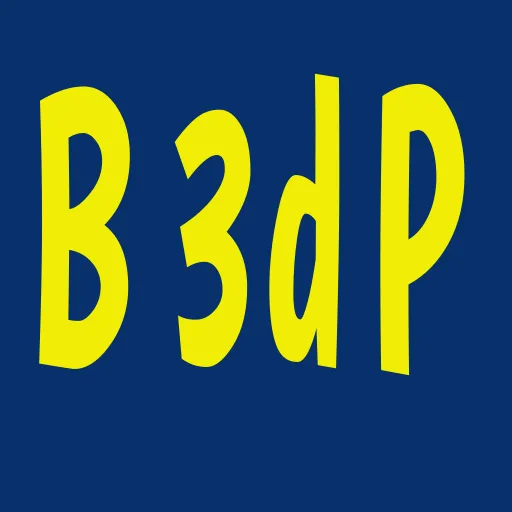Whether you like it or not with the 3d print process you need to incorporate slicer software within your workflow…
You need a 3d slicer within your 3d print workflow because you need to translate your cad model to data that your 3d printer can understand. The 3d printer is a dumb machine and needs to be told exactly what to do.
What a slicer is and where it fits in the workflow is briefly outlined below…
What is the 3d print process
Stepping back a bit we can look at the whole of the 3d printing workflow to see where the slicer fits in…
So you have an idea of what you want to print. To get from here to the computer you need CAD software ( computer aided design) …or know someone who is good at it…
Once you have the 3d model created and it is the right size then you save or export it as a file format the slicer can understand …and this is .stl, .obj, .dae or .amf ( these are different formats of the data, the most common being the .stl ( stereolithography)).
You now open the slicer and import the model file…if it is the first time then you will have to setup how your printer works…there is normally a guide for this…
You set the quality of the model to print and the type of material to print with, you can use the basic interface or get very in depth…you then save this as a file for the printer to understand…
Load that onto a sd card( preferable) or you can use a network to send the file across from your computer…
Load the right material into the printer, make sure it is setup right and select the file and print…
Wait a while ( and a bit more), then remove the model from the build plate and examine it for flaws…
Remove any big flaws and nod satifyingly…or look at what happened and ten work out what you need to do in the slicer to get it to print better or even just print..
So that is the 3d print workflow and you can see where the slicer fits in and how important it is…

Let’s have a more in depth look at why you need a 3d printer slicer….
Why do you need a slicer
The slicer program performs the necessary translation between the general cad file and your specific printer. It allows you to choose the material, layer height and multiple other advanced features to adjust. You then create a specific file for the model to be created on your printer.
What you will find is that as you gain experience with your printer, you will tweak the settings and store them as profiles for different material…or even down to colors of materials…as things like temperature or flow rate will affect the prints…
Your 3d printer needs to be told exactly what to do and the file created from the slicer does this…
Think of it as a complete set of instructions…
So you need to tell the printer what temperature to set things to and where to move and how fast you can move, how much plastic to push out and other things…
You can look at the output of the slicer and see what your printer is going to do ( and this is one of the things you really should do before printing)…
But how does it do it, let’s have a quick look…
How does a slicer work
So you have saved your CAD model as a stl file, this file contains all of the mesh information of your model.
The mesh information is a representation of the outer surfaces as triangles…
And each line must be part of two triangles or the model is what is termed as ‘not watertight’ or has holes and the slicer may or may not be able to slice it….
If your model is watertight then opening it will show you an outline of what you are going to print…
Now you need to set the slicer up to translate that representation into slices for your printer to print…
You can control the layer height ( quality – the larger the layer height the more noticeable the lines on the printed model)..
The speed of the printer( determined by how much eat you can put into the hot end and the current through the motors to prevent overrun)…
The thickness of the walls, the amount of infill…to determine how strong the model will be…
If any supports will be necessary…the printer cannot print into free space easily, so any overhangs must be evaluated to determine whether they can be printed or whether they will need supporting form the build plate and extra material printed as these supports.
The slicers coding determines what it determines as an outside wall, an inner wall and infill. Each of these can be modified to print the model with the features you want…
But everything will be a tradeoff, you will more often than not be trading time against quality. A model printed at 0.3mm layer height will take a lot less time than one printed at 0.1mm layer height, but the layers will be less noticeable with the 0.1mm…

The slicer, if set up with the parameters your printer uses, will give you a useful estimate of printing time. I would use this as a guide rather than being a very accurate timing. This is due to delays for reading the SD card, or network transfers and other parts of the printing process not being added in the slicer.
The main things you setup for the slicer are
- The material type, so your printer knows what temperature is required for the bed and nozzle.
- The layer height, so that the printer knows how much material to extrude over what time, along with the wall thickness.
- The place where your model is to be printed, most use the middle of the bed – but i have found most beds dip in the center so you get the most failures there…i tend to move the model to the front left corner, this way i can optimize my printers bed leveling in this area if there are issues.
- Speed of the printer while printing and moving from area to area, so you don’t get shifting layers from going too fast or oozing from going too slow.
- And any support material required for printing into free space.
The slicer will then take this information along with the models and create a layer by layer set of commands for your printer to follow.
Once sliced the layers can be looked at to see if it is what you want…
Most slicers will show you which type of line will be printed where, so you can determine the quality of the model.
Then this is saved to your computer or an SD card…
But you hear of so many slicers and i bought an ender 3, what slicer can i use…
Let’s have a look…
Can you use any slicer for 3d printing
Ok so you bought an ender 3 printer…are you stuck using the slicer they supplied with it…
No you are not, there are some printers coming through that require a special format for the printer to recognize, which is a shame as it is departing form the initial concept of open source to proprietary formats.
But on the whole the 3d printers are dumb machines that are looking for gcode (positional and control information) commands to execute, so most of the slicers are compatible with them…
There are differences between slicers and it is worth trying a few to see how you get on with the interface and how the model prints…
You would expect most slicers to create the same gcode, but this is not the case…I have found that there are marked differences between slicing in Cura and Prusaslicer…
It maybe that you get to know more that one slicer for different types of models…
As long as the slicers stay open source then they will be available to anyone to use…
There are some that are paid for programs, like simplify3d, KISSlicer or selfcad and you will have to try those out to see how you get on with them….
Believe it or not two printers of the same make will perform differently with tow different slicers creating files for the same model…so it really is up to you to try out a couple of options…
So unless your printer has a custom file format then you can use any of the free or professional slicers to take your model from the cad or download to the information required for your printer….
If you are a beginner then Ultimaker Cura is a good one to start with as it has several levels of customization available, from a beginners level to maximum customization with hundreds of adjustments…
Another one to explore is Prusaslicer, a spin off from slic3r, which is bundled with every prusa printer.
Thanks for reading
